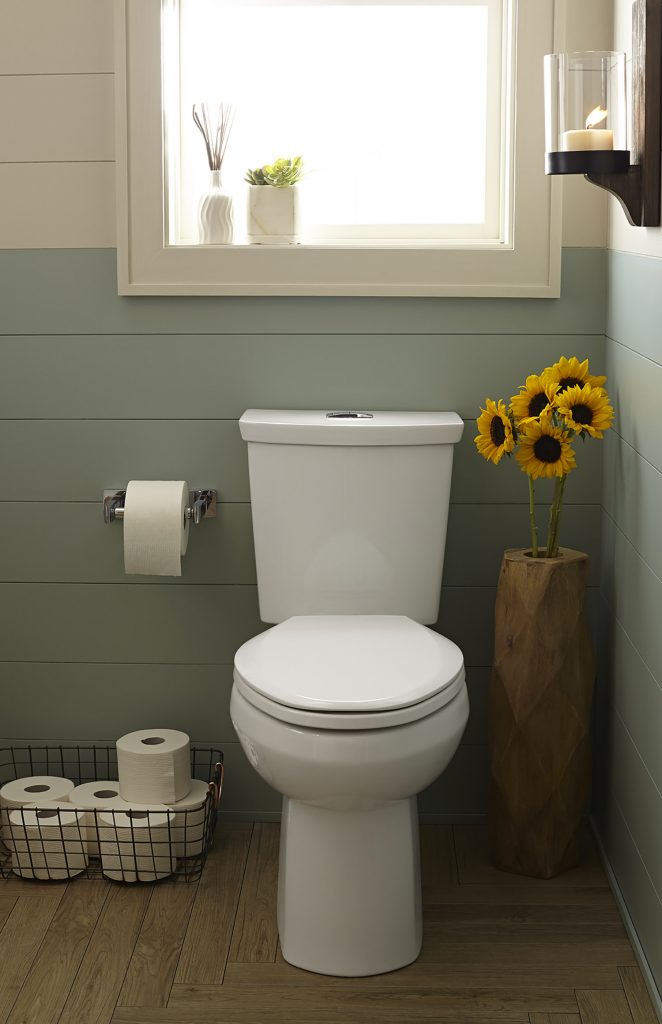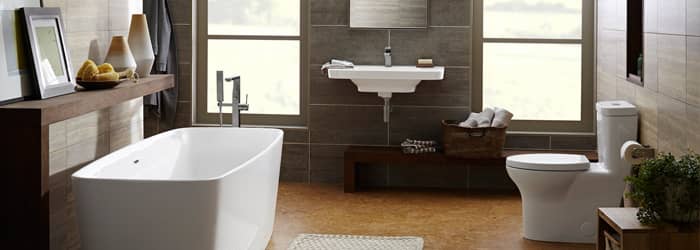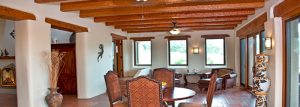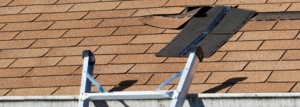When people think about remodeling bathrooms, they often zero in on cabinets and countertops and showers, but styles are changing in other bathroom basics — like toilets, tubs, and sinks. So we asked some local experts about what Arizona homeowners look for in these major fixtures when they “buy” a new bathroom.
TOILETS
There are literally hundreds of models of toilets on the market at hardware stores and plumbing supply companies in America. White remains the color of choice in Arizona, particularly for contemporary style baths, although earth tones, grays, off-white and “biscuit” are gaining popularity — but not avocado or dusty rose.
“Some people want black, but it’s difficult to prevent water spots on black with our hard water in Arizona. You’re cleaning and polishing all the time,” said Alex Oorin, a showroom manager for Ferguson Bath, Kitchen and Lighting which has outlets throughout Arizona.

Toilet tanks seem to be shrinking, largely because federal regulations require that the flush in toilets be limited to 1.6 gallons of water. But some toilets have only a 1.28 gallon flush, according to David Pruitt, a manager with Van Marcke Trade Supply in Phoenix and Scottsdale.
“But most people don’t like 1.28 because it doesn’t work too well; there’s about 25 percent less water than 1.6,” Pruitt said.
There are also lots of dual flush models on the market that allow you to choose a smaller flush or a larger flush.
According to Pruitt, the most popular brands are Kohler, American Standard and Toto. But he also sells a lot of Briggs, Elkay and Crane, which tend to be cheaper, “but there’s nothing wrong with them; they have the science down.”
Then there are style questions. Traditional toilets are always in demand; sleeker designs are preferred for a contemporary look.
Two-piece toilets with a tank attached to a bottom are what most homeowners are familiar with. But one-piece toilets with the tank and bottom in one solid fixture with no seam in- between have gained in popularity; so are toilets with a “skirt” and no p-trap swirling around the bottom. The advantage is that they are easier to clean. People also like one-piece toilets because they’re often smaller. “But unless the manufacturer installs a pressure assist device inside the toilet, you can never get a good enough flush,” Pruitt said.
Pressure-assisted toilets can be noisier and also need a minimum of at least 25 pounds per square inch of water pressure in the house.
“Comfort height” toilets are also popular – seating is usually about 17 to 19 inches off the floor, about two or three inches taller than usual – better for adults but maybe not for children.
The top three single flush models in Consumer Reports for 2016 come from St. Thomas Creations ($350), American Standard ($240) and Delta ($270). But Toto, Glacier Bay and Kohler models also did well in the top 10. The highest scoring Glacier Bay only cost $100.
TUBS
In the past few years, we’ve seen many homeowners remove bathtubs to build showers instead. If they do have tubs, they look for standalone models to save space.
Some homeowners choose standalone tubs that could be used by two bathers at once. But tubs can be much smaller – maybe five feet long.
With these standalones, the spigot doesn’t come out of the tub itself. You’ll need a standalone set of tub-filling pipes and faucets installed right next to the tub. You can even have a standalone pipe with a hand-held sprayer device. These pipes and spigots can come in the same style and material as the rest of the faucets in your bathroom. And of course, the finishes used on faucets and pipes include many choices: black, bronze, brushed nickel, chrome, gold-finished brass, metal with glass trim. You can even find pink, blue or orange. The drain goes into the floor under the tub.
With a standalone tub, Pruitt suggested buying one with a depth of 17- to 18-inches. “People want the deeper ones so they can lie down in the tub and be almost completely covered with water,” he said. “They’re more expensive, but if you can’t buy one now, wait another year until you can.”
Today’s standalone tubs can be made of: thin-stamped steel, coated with porcelain; molded sheets of acrylic and fiberglass; fiberglass with a gelcoat (the least expensive); or cast iron coated with enamel (the most expensive). There’s even a highly polished mixture of crushed limestone and silicone. “It looks like porcelain,” said Jeremy Smith, manager of Central Arizona Supply’s showrooms in the Phoenix area. “But when you touch it, you know that it isn’t.”
SINKS
Demand has dropped considerably for pedestal sinks, said Oorin, mainly because these sink units have so little counter space available for bottles and jars or even a comb. But instead of installing cabinets, topping them with granite or quartz countertops and then dropping in a sink or two, some homeowners buy vanity cabinets especially made for the bath. These are units sold with countertops and sinks integrated into the whole unit.
These are not cabinets originally designed for the kitchen, they’re cabinets that look like furniture and have “insides” that make life easier, like outlets for hair dryers and shavers and electric toothbrushes. Cabinets are big enough to store those small appliances, too, so they don’t clutter your countertops.
Dramatic looking vessel sinks remain popular – particularly for powder rooms. But they’re not made out of glass anymore because glass is harder to clean and keep spot-free. The latest vessels are made from concrete or metal — like copper or brushed nickel.
###
Photo Credits: American Standard

















